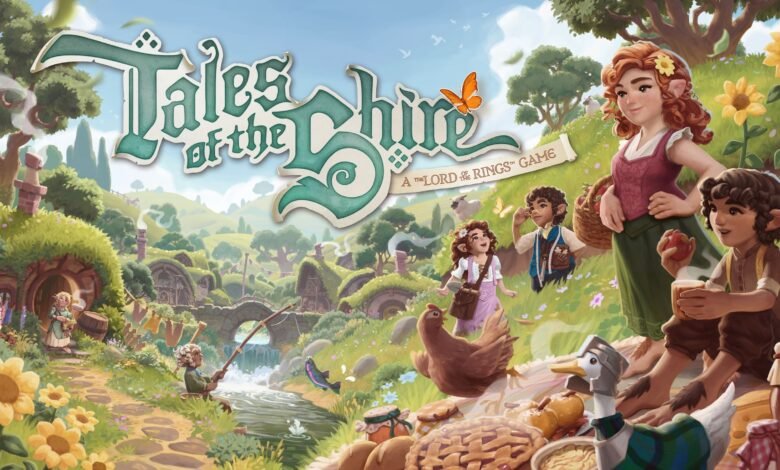Tales of the Shire Review: A Disappointing Wait for Little Reward

▼ Summary
– Tales of the Shire fails to deliver on its potential due to bugs, poor optimization, uninspired dialogue, and ill-paced progression, making the Hobbit life simulator tedious instead of enjoyable.
– The game’s development was plagued by multiple delays, and despite extra time for improvements, it still suffers from a weak plot, half-baked features, and flavorless characters like a bland Gandalf.
– Gameplay involves activities such as farming, foraging, fishing, and cooking, but these are marred by slow pacing, repetitive fetch quests, and frustrating navigation without a map overlay.
– Technical issues persist, including frame rate drops, character stuttering, quest bugs, and frequent game crashes, which disrupt the experience and require replaying lost progress.
– While home decoration and cooking offer some enjoyment, they are overshadowed by the game’s overall lack of heart, poor execution, and inability to satisfy Lord of the Rings fans or simulation enthusiasts.
Exploring the charming world of Hobbit life should feel like a warm embrace, but Tales of the Shire: A Lord of the Rings Game struggles to deliver that cozy magic. Despite promising foundations for a peaceful life simulator set in Tolkien’s beloved Shire, the experience is marred by technical issues, uninspired writing, and pacing that tests your patience more than it rewards it.
It’s genuinely disheartening to see another video game adaptation of The Lord of the Rings fall short of expectations. This particular title aims to immerse players in the daily routines of Hobbits, yet it transforms what should be delightful simplicity into a monotonous grind. Players will find themselves performing tedious chores like walking slowly and managing a cluttered inventory, which quickly drains any sense of joy from the adventure.
The game’s journey to release was anything but smooth. Developer Wētā Workshop delayed the launch multiple times, moving it from Fall 2024 to a final July 2025 date. While these postponements suggested necessary refinements were underway, the final product still feels undercooked. Early demos hinted at a world in need of more life and polish, and unfortunately, the full game fails to address those shortcomings.
Upon finally completing the game months after its release, the overall experience felt draining. Watery plotlines, underdeveloped features, and characters lacking personality make progression a chore. Even the legendary wizard Gandalf, who makes brief appearances, comes across as surprisingly bland, a true disappointment for fans of the source material.
The core issue appears to be poor direction. Instead of rewarding patience, the game penalizes efficiency. Rather than encouraging creativity, it pushes players toward repetitive shortcuts. Intended to be light and fun, it instead becomes boring, forcing you to spend days searching for elusive mushrooms just to complete mundane tasks for neighbors.
Your adventure begins with a familiar scene: Gandalf greets your custom Hobbit character on a country road, offering a ride to the village of Bywater before departing. The tutorial introduces you to townsfolk and the basics of Hobbit life, farming, foraging, fishing, and building relationships to improve your standing in the community.
The central storyline involves a group of local Hobbits working to officially designate Bywater as a township. This quest is sprinkled with moments of Hobbit-like whimsy, such as fabricating a wolf’s head for the town gate despite none of them ever having seen a real wolf. These clever touches provide brief enjoyment, but they are sadly rare.
Dialogue is plentiful but shallow. Most characters are defined by single, unchanging traits, the grumpy fisherman, the sweet elderly cook, the simple farmer. While Hobbits are known for their simplicity, the lack of character depth or voice acting makes interactions feel hollow and unrewarding.
It’s quite an accomplishment that Tales of the Shire manages to make Gandalf seem uninteresting. His limited screen time lacks the wisdom and charm expected from the iconic wizard. A particularly lackluster firework scene feels like an outright disservice to Tolkien’s vivid descriptions.
A few characters do stand out, such as Hobson, the bumbling trader always trying to offload junk, and Delvinia, an herbalist grappling with her mother’s legacy. These figures offer glimpses of the heart and depth the game desperately needs.
Building relationships is a key mechanic, primarily achieved through shared meals. You receive hints about villager food preferences via mailbox notes, and fulfilling these cravings speeds up friendship growth. Cooking emerges as one of the more engaging activities, offering a sense of purpose as you gather ingredients and prepare dishes.
Bywater itself is visually appealing, with rolling hills and pastoral scenery that eventually win some affection. Navigation is intentionally slow, there’s no map overlay, so you follow bluebirds perched along paths. Initially frustrating due to dead ends and impassable terrain, learning the layout becomes a lesson in patience.
Pacing remains a significant problem. Some days drag with little to do, ending with your character waiting for nightfall. Other days flood your mailbox with villager requests, sending you on repetitive fetch quests across the map. This inconsistent flow allows players to rush through the main story too quickly.
A guild system is introduced late in the game, letting you form groups around core activities like farming and fishing. Fulfilling guild requests earns progression points and unlocks perks, but its late arrival encourages grinding rather than organic play.
Technical issues further hinder the experience. Frame rate drops, character stuttering, and quest bugs are common, and the game may crash entirely, forcing you to replay entire days. These problems persist months after launch, affecting players across platforms.
Home decoration stands out as a genuine highlight. Starting with a modest smial, you can expand and personalize your space using furniture received as gifts or purchased in town. This creative outlet adds meaningful engagement, making resource gathering and spending feel worthwhile.
The economy starts challenging but becomes unbalanced. Early on, selling foraged or farmed goods is your only income source. However, farming quickly breaks the system, vegetables grow out of season, allowing you to mass-produce crops with minimal effort. This undermines any strategic depth the farming mechanics might have offered.
Foraging and fishing provide fewer shortcuts. Fishing spots are limited and often yield common species. Since fish don’t stack and inventory space is tight, frequent trips to sell or store items become necessary, making remote fishing spots more trouble than they’re worth.
Ultimately, nearly every positive aspect of Tales of the Shire comes with a significant drawback. The game had the chance to address early criticism but largely ignored feedback, resulting in a flawed final product.
Should you play Tales of the Shire?
Consider it if you enjoy decorating a virtual home from the ground up or find relaxation in simple cooking simulations. However, steer clear if you seek an engaging, bug-free experience or are a dedicated Lord of the Rings fan hoping for a faithful, heartwarming adaptation. The simulation mechanics often feel disjointed, and the overall experience lacks the charm and polish this beloved setting deserves.
(Source: TechRadar)





